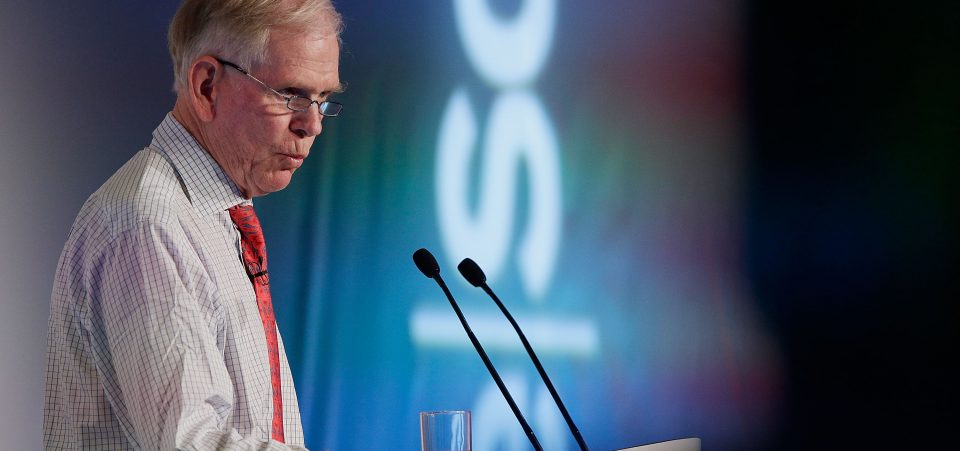Jeremy Grantham Bitcoin Prediction
If you’ve heard about, and especially if you respect, Jeremy Grantham, then you might want to reconsider that Bitcoin investment. Jeremy Grantham’s Bitcoin prediction is not bullish. He warns that the Bitcoin rally appears to have taken the proven and steady course that precedes a bubble burst. He says the wild “up and down” fluctuations that Bitcoin and other cryptocurrencies experienced in the fall of 2017 appear to have stabilized. That’s when investors should pay most attention. (Source: “GMO’s Grantham Joins Bitcoin-Bubble Chorus as Swings Subside,” Bloomberg, January 4, 2018.)
Jeremy Grantham, who has earned a reputation for being one of the best analysts when it comes to overvalued markets, a veritable bubble guru. Grantham co-founded the firm Grantham, Mayo and van Otterlo (GMO) in Boston. The firm built consolidated its bubble forecasting abilities, predicting and warning about the 2000 and 2007/2008 financial crashes. (Source: “Jeremy Grantham Predicted Two Previous Bubbles. And Now?,” The Wall Street Journal, November 5, 2017.)
It’s still early enough in 2018 to ponder the lessons from the past year that investors should keep in mind. Certainly, Grantham’s Bitcoin bubble fears are valid. In 2017, investors were lucky. While the mainstream took (and continues to take) shots against President Donald Trump, mocking his intelligence and very sanity, many in that same mainstream have earned handsome returns on Wall Street thanks to the tax cuts; the president has delivered. Now, whether tax cuts are enough to prolong the bull run into 2018, that’s another matter entirely.
The Markets Should Have Crashed in 2017
If the predictions of most top financial analysts on Wall Street and in the mainstream media had come true, Wall Street would have been crushed in 2017. The experts told us to expect a massive market collapse. In fact, their predictions were based on good logic and made such sense that nobody should ignore their warning of market collapse.
If anything, 2017 reminded us of the fickle nature of risks and opportunities; nobody really knows when and where they emerge. The Dow went from 20,000 to 25,000 and Jeff Bezos accumulated a personal fortune of over $100.0 billion. The most unpredictable market phenomenon of all was Bitcoin. What was once the currency of choice for people who wanted to live under the radar came into full and spectacular view.
No Holds Barred on a Crash in 2018
All this could change in 2018 if Grantham is right. There’s a good enough chance that he is, because Grantham’s housing bubble prediction did materialize, as the 2007-09 financial crash proved. Jeremy Grantham’s dot-com bubble 2000 prediction also materialized. Therefore, while we can hope he’s wrong, seasoned gamblers would not take those odds. Indeed, there’s little doubt that world markets, and the American stock market in particular, have been inflating valuations for a few years now.
Jeremy Grantham’s predictions for 2018 suggest that market valuations have gone beyond high. They have achieved a real frenzy; indeed, stock prices are downright decadent. Thus, they have reached the point that typically accompanies or precedes the most dangerous part of the bubble–the one where you don’t want to be, unless you’re shorting the market (it’s the late stage of the bubble). Grantham actually used “melt-up,” a term that combines associations of nuclear reactor disasters with an overall screw-up to describe what’s ahead in 2018. (Source: “GMO’s Jeremy Grantham Says Stocks Could Be Heading for a ‘Melt-Up’,” Bloomberg, January 3, 2018.)
The Melt-Up Is Coming
Bitcoin is an inherent part of the “melt-up.” Therefore, Bitcoin—unlike gold, for example—is no substitute for managing market risk. It’s not a hedge, it’s an inherent component of the irrational exuberance that has been driving the markets. Grantham suggests that Bitcoin could be the first to crack, generating a “mini-bubble.” That will serve as the trigger for a major market crash.
At their dramatic peak, Grantham’s predictions for 2018 include a 90% probability that Wall Street will lose some 50% of its value from its high. That would imply, given the Dow Jones, exceeded 25,000 points, a 12,500-point loss. All this could be happening within a period from six months to two years. (Source: “Bracing Yourself for a Possible Near-Term Melt-Up,” GMO, January 3, 2018.)
Grantham explains that he expects the melt-up to be of unusual intensity because there was no major market correction in 2017. However, the year certainly had a valid set of triggers for a financial crash. The uncertainties related to any number of factors, from Donald Trump (and the “Russiagate” Sword of Damocles that hangs over his presidency) to the series of European elections, which shook the foundations of the European Union, to the concerns of existential tensions in the Middle East to the Chinese economic slowdown should have produced even a modicum of tension.
Instead, investors seemed completely immune; nothing scared them. Sooner or later, Grantham argues, that fear will materialize and spread to the financial markets. The reason it might be worthwhile to heed his cautionary approach to 2018 is that the very risks that could and should have caused corrections in 2017 haven’t gone away.
Italy votes in March and a Euro-skeptical party could end up winning. Also, while the bulk of ISIS has been defeated, the chances of a U.S. led war against Iran—making Iraq look like a cakewalk—have increased. Trump’s recognition of Jerusalem as Israel’s capital has exacerbated tensions in the entire Middle East. It will have repercussions. Then there’s the big unknown of the Trump tax cuts and how the incoming Federal Reserve Chair, Jerome Powell, will manage interest rates. Raising the nominal interest rate by one half of a percentage point (to defend the dollar or confront the expected growth effects from the tax cut) could be fatal.






